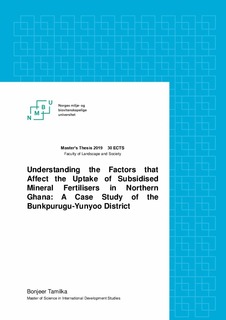| dc.description.abstract | The mineral fertiliser subsidy programme in Ghana that kicked-off in 2008 went through peaks and valleys in ensuing years. But in 2017/8, it was apparently hauled up on the banner of ‘planting for food and jobs’. This study sought to understand the factors that affect the uptake of subsidised mineral fertilisers under this supposed revitalised subsidy regime and the challenges associated with it. The study was conducted in the Bunkpurugu-Yunyoo district of the northern region of Ghana. A mixed method of inquiry was used covering one hundred and two households. Qualitative interviews were also carried out with retailers of fertilisers and agricultural extension officers.
The study reveals that some of the challenges of the previous years’ relating to the penetration and/or availability of subsidised fertilisers significantly dwindled in 2018. This was found to be the result of the expansion of the fertiliser retail network and the high volumes of fertilisers that were supplied in the area. However, some farmers were still not able to access their preferred brands of fertilisers. Also, farmers who planted in the early part of the season partly used non-subsidised fertilisers because of the relatively late supply of the subsidised fertilisers. The direct issue of coupons to farmers by authorised field agents to access subsidised fertilisers under the programme did not also go as directed, as these agents and local political party leaders hoarded the coupons and later sold them to fertiliser retailers. By paying for these coupons, rather than receiving them for free, the profits retailers would have made for supplying fertilisers in the area were negatively affected.
A number of factors were found to have significant effects on the uptake of subsidised fertilisers. Uptake increased with the education levels of the heads of households and livestock owned by households, but decreased with off-farm work, the size and fertility levels of farmers’ plots, including farmers’ risk perception and the distance of their plots from their homesteads. It was also found that the gender and the age of the head of the household matter in the uptake of subsidised fertilisers, as male and younger heads used more fertilisers than their counterparts.
It is suggested in this study that further studies are needed to understand the following: how input subsidy programmes produce losers and winners in the distribution chain; why having an off-farm work is associated with diminishing involvement in farming activities; and measures of risk could be individually tested against the uptake of subsidised inputs. | nb_NO |

